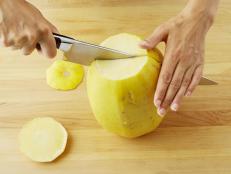1 / 10
Discovering Ambrosia
Take a bite of your firstAmbrosia and your expectations for what an apple should be will change forever. Crisp, honeyed and exceptionally juicy, this prized newcomer is what produce industry experts hope for when they talk about raising the bar — and numbers show that shoppers feel similarly. In 2014, Ambrosia sales jumped over 47 percent, moving the apple into the top 10 selling varieties in the U.S. for the first time. This retail feat is even more impressive when you consider Ambrosia's fortuitous start: The first tree was discovered in British Columbia just a little over 20 years ago, when a chance seedling cropped up among an orchard ripe with Jonagolds. Against all odds, the seedling transformed into a healthy apple tree, and in the early 1990s, it bore its first fruit. Today, Ambrosia apples are grown exclusively by the McDougall family in the heart of Washington's Columbia River Valley. Here’s a behind-the-scenes look at the fall Ambrosia harvest, from the nursery all the way to the kitchen table.












































